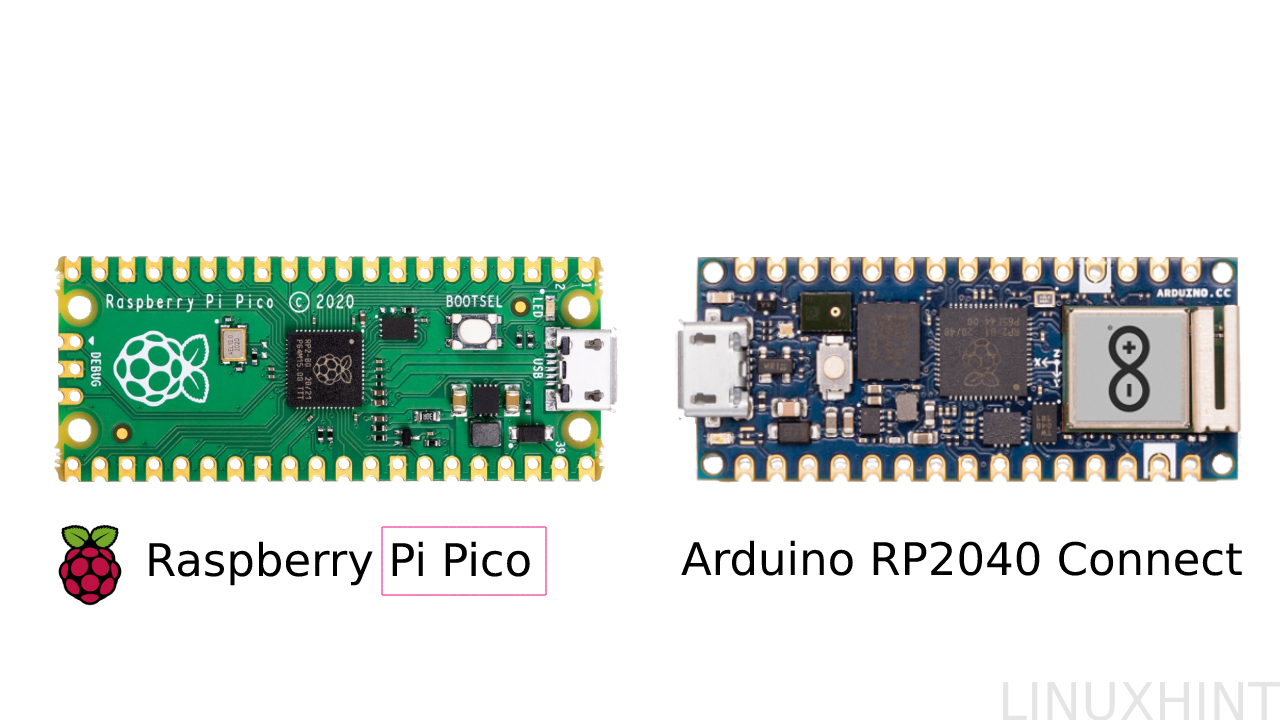Raspberry Pi Pico versus Arduino Nano RP2040 Connect
The first thing that everyone should go for before choosing between Raspberry Pi Pico and Arduino Nano is the specifications of both boards, for that a table is given below that states the specifications of both boards:
| Specifications | Raspberry Pi Pico | Arduino Nano RP2040 Connect |
| Controller | RP2040 controller | RP 2040 controller |
| RAM | 264 KB | 264KB |
| Memory | 2MB | 16MB |
| GPIOs | 26 | 20 |
| Form Factor | 21 mm × 51 mm | 45.6 mmx18 mm |
| Ports | 1 × USB 1.1 | 1xMicro USB, |
| Clock Speed | 133 MHz | 133MHz |
| Connectivity | No connectivity option | Wi-Fi, Bluetooth |
To further make a detailed comparison of both boards we have analyzed both based on following parameters:
Usability
The first part that every user looks for before choosing between the two is which board will be easy to use and work with. So, competition seems to be tough between the two as both have almost the same form factor though the Pi Pico has 6 more GPIOs which makes it a little bit ahead of the Arduino Nano RP2040 Connect.
Similarly, Arduino Nano RP 2040 Connect comes with a lot more features like Bluetooth, Wi-Fi, RGB LED and microphone. So, if you are looking forward to having a board which you can connect wirelessly with other devices without attaching any extra peripherals then it would be easy in case of Arduino Nano RP2040 Connect.
Coding
The next thing that is worth considering while selecting between the two is which programming languages both support and which one is easy to program. Both the boards support C/C++ and Python. Normally the Python language is preferred, so for that you need to install “Thonny” IDE as it works well for both Pi and Arduino.
The process for connecting both boards is similar as in Pi you must press the “Bootsel ” button and in Arduino you must short the GND and REC pins. Running the code on Arduino is quite easy according to my perspective as in this case you don’t need to copy any file to the board as in the case of Pi Pico.
Cost
The last part is the cost of the boards so from the specification table you can clearly see that Arduino RP 2040 Connect is the winner but with more features cost also increases. The Raspberry Pi Pico is listed for sale for 9$ whereas the Arduino RP2040 connect comes with the price tag of 32$ which is quite a difference, to see further details on the sale offers on Raspberry Pi Pico click here and for Arduino RP2040 Connect click here.
Conclusion
Raspberry Pi foundation and Arduino both manufacture best development boards but the difference comes when the user shortlists the purpose for which he/she needs the board. The Raspberry Pi Pico and Arduino Nano RP2040 Connect both are excellent boards as both come with the same controllers but there are some differences in the features. If you are looking for a less costly board and do not require WiFi and Bluetooth option, then Raspberry Pi Pico is the best buy for you. On the other hand, if you are looking for a board that has advanced features then go for Arduino Nano RP2040 Connect.

